Abstract
The Porya Guba clinopyroxenite–wehrlite complex is located in the core of the Lapland–Kola collisional orogen (~2.0–1.9 billion years old) in the northeastern part of the Fennoscandian Shield and contains iron–titanium–vanadium and nickel–copper mineralization with platinum group elements (PGEs). The controversial geological position of the complex within the mafic granulites of the Kolvitsa mélange (pre-, syn- or post-orogenic) is clarified by Sm-Nd isotopic dating of the rocks and mineralization. The Sm-Nd age of the barren clinopyroxenites that dominate the complex is 1858 ± 34 Ma (εNd(T) = −1.5) and is interpreted as the time of its emplacement as evidenced by a sample from the largest intrusion, named Zhelezny. This age is younger than that of the peak of granulite metamorphism in the host rocks (1925–1915 Ma) and coincides within error with the age of rutile from granulites (1880–1870 Ma), indicating the time at which cooling to 450 °C occurs. Emplacement in the cooled rocks is confirmed by the detection of quenching zones in clinopyroxenites around granulite xenoliths. Magnetite ores, as well as mineralized pyroxenites with sulfide disseminations, are formed during a late stage of the complex development, as suggested by active assimilation of granulite xenoliths by these rocks. The isotopic age of mineralized pyroxenites enriched in PGEs is 1832 ± 35 Ma (εNd(T) = –2.0), while the age of magnetite ores is 1823 ± 19 Ma (εNd(T) = –2.5). Thus, the obtained isotopic data indicate that the emplacement of the Porya Guba complex and probably other small mafic–ultramafic intrusions in the Kolvitsa mélange granulites took place after the end of the Lapland–Kola collision.
1. Introduction
The Fennoscandian Shield is part of the Eastern European Craton [1]. The northeastern part of the Fennoscandian Shield is located in the Murmansk (Kola) Region of the Russian Federation. The Fennoscandian Shield and its northeastern part are characterized by a complex geological structure formed as a result of processes occurring since the Archean Eon. For example, the Siurua trondhjemite gneisses within the Pudasjärvi granulite belt in Finland were formed 3.5 billion years ago [2]. A number of problems related to the reconstruction of the geological history of the Fennoscandian Shield can only be solved using isotope geochronology methods [1,3,4,5,6,7,8,9,10,11,12,13,14,15,16,17,18]. One such question is the relationship between small mafic–-ultramafic intrusions and mafic granulites that developed within the Kolvitsa mélange in the southern part of the Kola Region [19,20].
Small mafic–ultramafic intrusions are widely developed among the Kandalaksha-–Kolvitsa mafic granulites (Kolvitsa mélange) and are represented by two complexes: the Porya Guba clinopyroxenite–wehrlite and the Plotichya Varaka schriesheimite–cortlandite–gabbronorite. On the one hand, the intrusions are located within the mélange [20,21] and could have formed before the collisional granulite metamorphism. According to current estimates, granulite metamorphism is restricted to the interval between 1925 ± 1 Ma [22] and 1915 ± 7 Ma [23]. On the other hand, recent dating of zircon from hornblende ultramafic rocks of the Plotichya Varaka intrusion (1913 ± 5 Ma [24]) shows that these intrusions could have formed at the very end of the granulite metamorphism period and are thus syncollisional. However, some researchers [19] note the presence of granulite xenoliths in clinopyroxenites, indicating the formation of the Porya Guba complex under post-orogenic conditions. In the light of the above discussion, isotopic geochronological studies of the Porya Guba complex are highly relevant.
The Sm-Nd isotope system was chosen for dating the Porya Guba complex because the separation of good quality zircon from ultramafic rocks for more accurate U-Pb studies did not yield results. Sm-Nd dating was performed on host and mineralized rocks of the Kolvitsa iron–titanium–vanadium deposit located in the Zhelezny intrusion [19]. It should be noted that this deposit has recently attracted attention due to the large number of platinum group minerals found in the zones of sulfide disseminations around magnetite ore bodies [25].
2. Geological Setting
2.1. Main Features of the Geological Structure of the Kola Region
The Kola region is the northeastern part of the Fennoscandian (Baltic) Shield and consists mainly of Precambrian crystalline rocks [21,26,27]. In the Kola region, three main geological subdivisions (from oldest to youngest, Figure 1) can be distinguished: (1) a late Archean basement with granitoid gneisses and relics of greenstone belts; (2) early Paleoproterozoic (2500–2000 Ma) rift-related volcanic and sedimentary complexes deposited on the Archean basement; and (3) early Paleoproterozoic (ca. 2100–1930 Ma) granulite belts composed mainly of juvenile sedimentary and volcanic rocks metamorphosed during the Lapland–Kola collision [26].
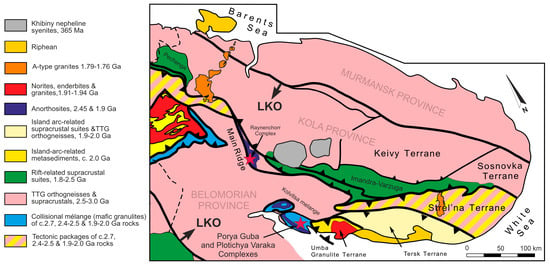
Figure 1.
Tectonic scheme of the Kola region showing the location of the Raynenchorr and Porya Guba clinopyroxenite–wehrlite complexes. Modified after [26]. Abbreviations: LKO, Lapland–Kola orogen.
It should be noted that the development of rift-related complexes on the rocks of the Archean basement began with the stage of initial magmatism, which included the emplacement of large layered mafic–ultramafic intrusions at the turn of 2.5 Ga [28,29,30]. The largest Paleoproterozoic greenstone belt is the Pechenga–Imandra–Varzuga belt, whose volcanogenic and sedimentary rocks accumulated during 500 Ma [31]. The filling of the rift-related troughs was accompanied by eruptions of ferropicritic magma, the deep- seated analogs of which are ore-bearing gabbro–clinopyroxenite–wehrlite intrusions in the Pechenga structure [32]. The U-Pb age of the gabbro–wehrlite intrusions hosting the well-known world-class Pechenga Cu-Ni deposits is 1985 ± 10 Ma [33]. The Lapland and Umba granulite belts and the Kolvitsa mélange (Kandalaksha–Kolvitsa mafic granulites), located south of the Pechenga–Imandra–Varzuga greenstone belt, were formed during the orogenic stage of the region’s development. The peak of granulite metamorphism within the Kolvitsa mélange is estimated to be between 1925 and 1915 Ma [22,23]. This time corresponds to the culmination of the evolution of the Lapland–Kola orogen separating large Archean blocks of the Earth’s crust. The post-orogenic stage (Figure 1) is characterized by the emplacement of large granitic plutons with ages 1.79–1.76 Ga [34,35,36,37].
The geological position of the small clinopyroxenite–wehrlite intrusions, including the Raynenchorr and Porya Guba intrusive complexes, is ambiguous (Figure 1). The Raynenchorr complex has a cut position to anorthosites of the Main Ridge complex with an age of 2.45 Ga [38]. The isotopic age estimate of the Raynenchorr complex [38] has a large error (1863 ± 77 Ma). Meanwhile, the Porya Guba clinopyroxenite–wehrlite complex is located within the Kolvitsa mélange [20] and thus its relationship to granulite metamorphism is not clear. Some researchers have estimated the time of emplacement of the clinopyroxenite–wehrlite intrusions to be pre-orogenic, preceding the peak of granulite metamorphism (e.g., [39]). An additional argument in favor of the ancient age of the Porya Guba complex, which contains a large iron ore deposit, is the similarity of the petrographic composition and ore potential of the complex to the differentiated gabbro–wehrlite intrusions of Pechenga with an age of 1985 ± 10 Ma [33]. In addition, the region is known to be characterized by the dominance of acidic rather than ultramafic intrusive magmatism during the post-orogenic stage (Figure 1).
2.2. Geology of the Porya Guba Complex on the Example of the Kolvitsa Deposit of Iron Ores
The Porya Guba complex forms a chain of intrusions (Figure 2) in the structure of the Kolvitsa mélange with a total length of more than 20 km, oriented in the northwestern direction [19,25,40].
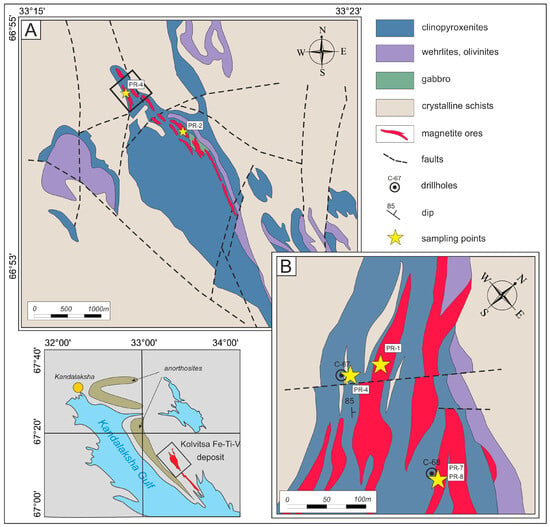
Figure 2.
Schematic geological map of the Zhelezny intrusion, northwestern part of the Porya Guba complex (A) and detailed map of the Kolvitsa Fe-Ti-V deposit (B). Compiled using [19] and references therein.
It is convenient to consider the geological structure of the complex using the example of the Kolvitsa Fe-Ti-V deposit, located in the Zhelezny intrusion (Figure 2 and Figure 3). The 4 × 1 km Zhelezny intrusion is composed predominantly of clinopyroxenites (Figure 2). The subordinate group of rocks of the Zhelezny intrusion is represented by wehrlites, olivinites, websterites, olivine clinopyroxenites, and magnetite ores [19] and is considered to be a late phase of the intrusion [25].

Figure 3.
Cross-section of the Kolvitsa Fe-Ti-V deposit. Compiled using [19] and references therein.
The magnetite ores of the Kolvitsa deposit form steeply dipping bodies of up to 50 m thick, which can be traced along strike for a distance of up to 1500 m, and a depth of up to 350 m. The average iron content in the ores is 40%, and the titanium and vanadium oxide concentrations are 7 and 0.2%, respectively [19]. Around magnetite ores, in olivine clinopyroxenites and websterites, a zone of sulfide disseminations with a chalcopyrite content of up to 10% develops. These disseminations are associated with platinum group element (PGE) mineralization with a Pt + Pd + Au content of up to 1 g/t at a thickness of about 3 m [25].
Field observations show that a quenching zone in the form of fine-grained pyroxenites of up to one meter thick (Figure 4) is formed near the sharp contacts of barren coarse- to medium-grained clinopyroxenites and garnet–pyroxene–feldspar crystalline schists (granulite xenoliths). In granulite xenoliths, recrystallization of some of the material occurs, and pegmatoidal textures appear. Xenoliths of crystalline schists in mineralized pyroxenites and magnetite ores have gradual boundaries arising due to assimilation of granulites. At the same time, the magnetite ores are enriched with garnet.
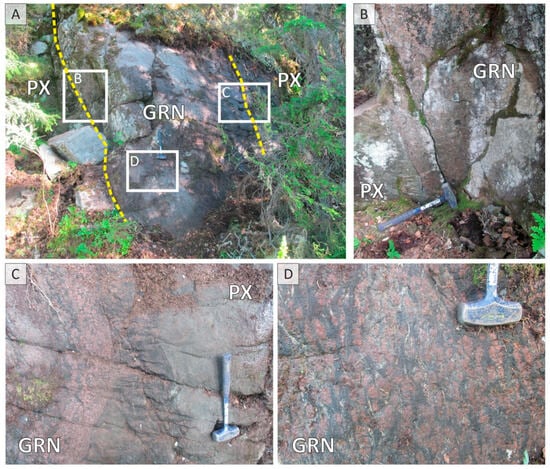
Figure 4.
Geologic relationships between granulite xenolith (GRN) and olivine clinopyroxenites (PX) in the Zhelezny intrusion of the Porya Guba complex. (A) General view of the cleared outcrop. Yellow dashed lines indicate the position of contacts. The length of the sledgehammer is 40 cm. (B) Northeast sharp contact of the xenolith where fine-grained clinopyroxenites about 1 m thick are adjacent to granulites. (C) Southwest sharp sinuous contact of granulites with coarse–medium-grained pyroxenites separated from xenolith by a zone of fine-grained pyroxenites about 30 cm thick. (D) Photograph of the central part of the xenolith.
3. Materials and Methods
During field work within the Zhelezny intrusion, one sample of clinopyroxenite (PR-4) and two samples of mineralized pyroxenite from the drill core (PR-7, PR-8) stockpiled at the drill site were collected for Sm-Nd studies, and two samples of magnetite ore were collected from exploration trenches in the northern (PR-1) and central (PR-2) parts of the intrusion (Figure 1). The weight of each sample is approximately 5 kg. The rocks were examined in thin and thick sections using an Axioplan II optical microscope. Mineral composition was studied using a LEO-1450 scanning electron microscope (Carl Zeiss Microscopy, Oberkochen, Germany) with mineral phase composition evaluated using a Quantax energy dispersive spectrometer at the Geological Institute (Kola Science Centre, RAS).
147Sm-143Nd Isotope Dilution Method
The concentrations of Sm, Nd, and neodymium isotopes were determined at the Collective Resource Centre of the Kola Science Centre, Russian Academy of Sciences (Apatity, Russia).
First, the samples were prepared by crushing; then, the minerals were separated using heavy liquids (Clerici’s solutions) and mineral fractions were selected under a binocular microscope. For the chemical decomposition of the samples, a 200–250 mg hand-picked sulfide mineral separate was taken [41,42]. Whole-rock samples were taken at 150–200 mg.
To determine the concentrations of Sm and Nd, samples were mixed with a 149Sm-150Nd tracer prior to dissolution, which was then diluted with a mixture of HCl + HNO3 in Teflon vials at 100 °C until completely dissolved. Afterward, individual samples were converted to chlorides by evaporating the sample in 4.5–6 N HCl. After the fractional acid decomposition, the dry residue was dissolved in ~1 mL of 2.3 N HCl. Further extraction of Sm and Nd was carried out with two-stage ion-exchange and extraction–chromatographic separation using ion-exchange tar “Dowex” 50 × 8 in chromatographic columns, employing 2.3 N and 4.5 N HCl as an eluent. The separated REE fraction was evaporated dry, dissolved in 0.1 N HCl, and loaded into the second column with Ln-Spec solid ion-exchange resin HDEHP (di(2-ethylhexyl) phosphoric acid). The resin was used to separate Sm and Nd. The separated Sm and Nd fractions were converted into a nitrate form, whereupon the samples were ready for mass-spectrometric analysis (Finnigan-MAT 262 solid-phase multicollector mass spectrometer, Waltham, MA, USA). Before use, Ta and Re filaments were degassed in a vacuum. Approximately 0.5 µL of 0.15 M H3PO4 was dried on an approximately 1.5–2 mm spot in the middle of the Ta filament at 2.5 A. The Nd and Sm analytes were dissolved with 1 µL of 0.2 N HNO3 and then loaded on the spot and dried at 1.2 A. The isotope Nd composition and Sm and Nd contents were measured in a static double filament mode, using Ta (evaporation) + Re (ionization) filaments. Data were collected for 8–10 blocks, with each block containing 10 runs. This measurement protocol resulted in good precision: ±0.003% for the Nd isotope composition and ±0.3% for the 147Sm/144Nd ratio. The error in the estimation of the Nd isotope composition in individual analysis was up to 0.01% for minerals with low (less than 1 ppm) Sm and Nd contents. The reduction in the raw isotopic data was performed offline (Excel). The quality of isotopic analysis was monitored through repeated measurements of the JNdi-1 standard reference material and the BCR-2 rock sample. The mean value of the 143Nd/144Nd ratio in a JNdi-1 standard was 0.512083 ± 15 (2σ, n = 11); for BCR-2, 143Nd/144Nd = 0.512625 ± 12 (2σ, n = 7), 147Sm/144Nd = 0.1379. The error in 147Sm/144Nd in the ratios was 0.3% (2σ), which is a mean value for repeated measurements in a BCR-2 rock sample [43]. Isotope ratios were normalized per 146Nd/144Nd = 0.7219, and then recalculated for the reference value 143Nd/144Nd in JNdi-1 = 0.512115 [44]. Unspiked standard JNdi-1 was run after each 3–5 unknown, and its average was used to determine a normalization factor for the measured 143Nd/144Nd values of R = (143Nd/144NdJNdi(avg.)/0.512115). This normalization factor was then applied to the 143Nd/144Nd ratio of all unknowns run in the same turret of 12 samples, and the errors were propagated to include the uncertainty of the correction. The blank intra-laboratory contamination was 0.3 ng in Nd and 0.06 ng in Sm. The accuracy of the estimation of the Sm and Nd contents was ±0.5%.
The values of εNd(T) were estimated using present-day values of CHUR as described in [45] (143Nd/144Nd = 0.512630, 147Sm/144Nd = 0.1960), DM as described in [46] (143Nd/144Nd = 0.513151, 147Sm/144Nd = 0.2136) and samarium decay constants λ147 = (6.524 ± 0.024) × 10−12/year [47]. Isochrones were calculated using the Isoplot R online software (version 1.1) [48].
4. Results
4.1. Petrography
Barren clinopyroxenites (Figure 5A,B) are coarse- to medium-grained rocks composed of clinopyroxene (75%–80%), olivine (5%–15%), brownish amphibole (5%–10%), orthopyroxene (<1%), and accessory apatite. Clinopyroxenites typically contain xenomorphic pyroxene obscured by dusty ore minerals and virtually unaltered olivine.
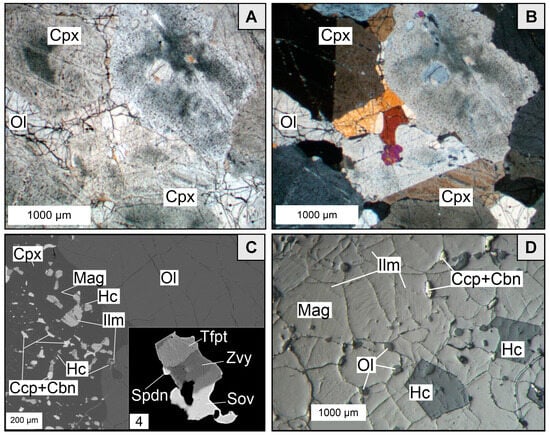
Figure 5.
Photomicrographs of barren olivine clinopyroxenites in (A) transmitted and (B) cross-polarized light. (C) BSE image of mineralized olivine pyroxenite containing platinum metal minerals (inset). (D) Photomicrograph of magnetite ore of the Kolvitsa deposit in reflected light. Scale lines are in µm. Abbreviations: Ccp, chalcopyrite; Cbn, cubanite; Cpx, clinopyroxene; Hc, hercynite; Ilm, ilmenite; Mag, magnetite; Ol, olivine; Sov, sobolevskite; Spdn, stannopalladinite; Tfpt, tetraferroplatinum; Zvy, zvyagintsevite.
Mineralized pyroxenites (Figure 5C) consist of clinopyroxene (20%–86%), brownish amphibole (5%–10%), olivine (1%–5%), orthopyroxene (1%–70%), ore minerals (3%–12%), and single grains of biotite, chlorite, serpentine, hercynite, and apatite. Mineralized pyroxenites are usually medium-grained rocks with varying proportions of clino- and orthopyroxene. A porphyritic structure is noted in orthopyroxene-enriched varieties. The major ore minerals are magnetite, chalcopyrite, ilmenite, pyrrhotite, and pentlandite. The main platinum metal minerals, found mainly in these rocks [25], are represented by zvyagintsevite, sobolevskite, stannopalladinite, froodite, and tetraferroplatinum. It should be noted that the content of platinum and palladium in sample PR-8 is 0.8 g/t according to atomic absorption analysis performed at the Geological Institute (Kola Science Centre, RAS).
Magnetite ore (Figure 5D) is composed mainly of magnetite (60%–90%), hercynite (5%–10%), and ilmenite (3%–7%) and contains varying amounts of silicate and sulfide minerals: olivine, clinopyroxene, amphibole, chalcopyrite, troilite, and pentlandite.
4.2. Sm-Nd Isotope Data
A total of five whole rock samples and 17 mineral fractions of rock-forming silicates (pyroxenes, olivine, amphibole, apatite) and ore minerals (pyrrhotite, troilite, chalcopyrite, pentlandite) were analyzed. Neodymium isotopic compositions in the studied sample set range from 0.510986 to 0.512773, while the 147Sm/144Nd ratio varies from 0.0890 for olivine to 0.2185 for clinopyroxene (Table 1). Neodymium concentrations range from 0.169 ppm to 459 ppm and samarium concentrations range from 0.037 ppm to 72.3 ppm. The minimum amounts of neodymium and samarium were determined in sulfides and olivine (less than 1 ppm).

Table 1.
Results of Sm-Nd isotope studies for rocks and minerals from the Zhelezny intrusion.
The Sm-Nd isochrone for barren clinopyroxenites plotted for the whole rock and rock-forming minerals corresponds to an age of 1858 ± 34 Ma, εNd(T) = −1.5 (Figure 6a). The age obtained can be considered as the time of formation of the Zhelezny intrusion. The intrusion apparently emplaced into crystalline schists after the peak of granulite metamorphism, which occurred in the interval 1925–1915 Ma [22,23], and already after their cooling to a temperature of 450 °C, reached by the turn of 1880–1870 Ma, judging by the time of closure of the U-Pb isotope system in rutile [23]. A similar Sm-Nd age was obtained earlier for the clinopyroxenite–wehrlite Raynenchorr intrusion located in the Main Ridge complex (Figure 1): 1863 ± 77 Ma with the value of εNd(T) = −1.8 ± 0.2 [38].
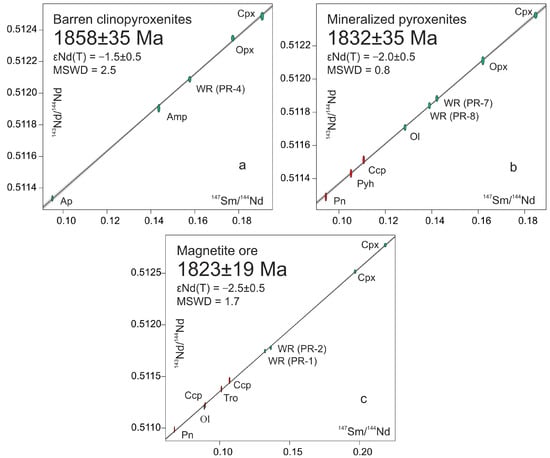
Figure 6.
Sm-Nd isochrones for rocks and ores of the Zhelezny intrusion: (a) barren clinopyroxenites; (b) mineralized pyroxenites; (c) magnetite ore. Abbreviations: WR, whole rock; Cpx, clinopyroxene; Opx, orthopyroxene; Ol, olivine; Amp, amphibole; Ap, apatite; Ccp, chalcopyrite; Pyh, pyrrhotite; Tro, troilite; Pn, pentlandite. Red ellipses indicate sulfide minerals.
For the mineralized pyroxenites, Sm-Nd mineral isochrones were calculated for whole rock powders, rock-forming minerals, and sulfide minerals from samples PR-7 and PR-8. The slope of the obtained regression line corresponds to an age of 1832 ± 35 Ma, εNd(T) = −2.0 (Figure 6b). Sm-Nd isochrones for whole rock powders and minerals from the magnetite ore (samples PR-1 and PR-2) indicate a slightly younger age of 1823 ± 19 Ma, εNd(T) = −2.5 (Figure 6c), which overlap within error with the Sm-Nd age of the mineralized pyroxenites. Thus, the isotope age estimate for the Kolvitsa deposit mineralization overlaps within error with the age of the host clinopyroxenites, confirming their association within the common complex.
5. Discussion
5.1. The Post-Orogenic Formation of the Porya Guba Complex and Other Small Mafic–Ultramafic Intrusions
The problem of the age relationship between the formation of the Kandalaksha–Kolvitsa granulites (Kolvitsa mélange) and small mafic–ultramafic intrusions has existed since the construction of the last geological map of the Kola region [39]. In the legend of this map, the small intrusions, presumably due to the similarity of petrographic composition and complexity of the structure of the host units, are located close, in terms of time of formation, to the 2.5 Ga layered mafic–ultramafic intrusions. However, small intrusions are located within crystalline schists that were metamorphosed to granulite facies in the 1925–1915 Ma interval [22,23]. The lack of significant metamorphic transformations in the rocks of small intrusions suggests that they are younger. This is supported by the quenching zones in pyroxenites around granulite xenoliths in the Zhelezny intrusion, as well as the Sm-Nd isotopic age of 1858 ± 34 Ma obtained in the present study after clinopyroxenites. This age overlaps with the 1880–1870 Ma estimate of the cooling time of crystalline schists after granulite metamorphism to 450 °C (Figure 7) [23].
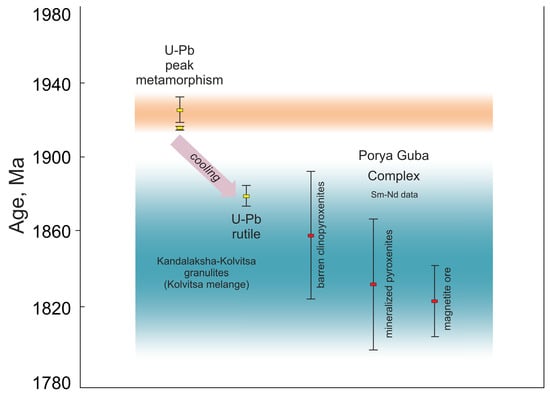
Figure 7.
Isotopic age of the main geologic processes in the Kolvitsa mélange. Based on the results of this study and published data [22,23].
The coincidence of the time of emplacement of the Porya Guba complex and the cooling time of the granulites is consistent with the presence of quenching zones in the clinopyroxenites and indicates post-orogenic formation of the complex.
Possible hypotheses for pre-orogenic and syn-orogenic formation of small intrusions, including the Porya Guba complex, are based, respectively, on petrographic similarities with the Pechenga intrusions with an age of 1985 ± 10 Ma [33] and preliminary data on the age of the Plotichya Varaka intrusion [24], determined by zircon to be 1913 ± 5 Ma. All isotopic ages obtained for clinopyroxenite–wehrlite intrusions, including the data on the Raynenchorr complex with an age of 1863 ± 77 Ma [38], contradict the first hypothesis. The syn-orogenic formation of small intrusions is inconsistent with the absence of significant metamorphic transformations of the rocks of small intrusions, as well as with the granulite xenoliths observed in the Porya Guba complex. Moreover, there is no evidence that zircon from the rocks of the Plotichya Varaka intrusion was not captured from granulites containing zircon of the same age.
Thus, Sm-Nd isotopic age data obtained for the first time for small clinopyroxenite–wehrlite intrusions of the Kandalaksha–Kolvitsa granulites indicate (1) the unity of clinopyroxenites and mineralized rocks of the Kolvitsa Fe-Ti-V deposit within the Porya Guba complex and (2) the formation of the Porya Guba clinopyroxenite–wehrlite complex under post-collisional geodynamic conditions, after the peak of granulite metamorphism of the Lapland–Kola orogeny, at the time of significant cooling of the Lapland–Kola orogen. Even though the idea of the two-phase nature of the Porya Guba complex [25] does not currently have geochronological confirmation, attention should be paid to its isotopic heterogeneity, expressed in the decrease in εNd(T) values from −1.5 in presumably early rocks (clinopyroxenites) to −2.0 or −2.5 in later rocks (mineralized pyroxenites and magnetite ores). This decrease is explained by a greater degree of contamination of the ore-bearing magma with granulite matter, as evidenced by their partially assimilated xenoliths in magnetite ores compared to xenoliths in barren clinopyroxenites accompanied by quenching zones.
5.2. Ore Potential of the Porya Guba Complex
The ore potential of the Porya Guba complex is associated with (a) the Fe-Ti-V mineralization of the Kolvitsa deposit located in the Zhelezny intrusion [19] and (b) the low-sulfide PGE-Cu-Ni mineralization developed both in the Zhelezny intrusion and in the adjacent intrusions of the complex [25]. The most promising area of the Kolvitsa deposit contains a series of convergent bodies of magnetite ores, which have been studied by drilling and trenching in the 1960s. Ore reserves are estimated to be up to 600 million tons [19]. Prospecting for PGE within the Porya Guba complex was carried out in the early 2000s and included only two new drill holes, which showed that pyroxenites with disseminated sulfides contained up to 1 g/t Pt + Pd + Au referenced in [25]. Later, Yu.N. Neradovsky and his colleagues [25] discovered more than 17 noble metal minerals in these rocks, most of which are platinum group minerals. Thus, the ore prospects of the Porya Guba complex can be assessed as high, taking into account the exploration and thematic work carried out, as well as the similarity with other ore-bearing complexes in Karelia and the Polar Urals, which have been the focus of some recent studies [49,50].
6. Conclusions
Combining field, petrographic, and isotopic geochronologic studies allows us to conclude the following:
- The Porya Guba complex, as noted by earlier researchers, consists of two groups of rocks. The rocks of the first group are mainly represented by olivine clinopyroxenites. No significant oxide or sulfide mineralization is noted in the rocks of this group. The second group is characterized by great petrographic diversity and includes olivine websterites, wehrlites, and olivinites, as well as magnetite ores and disseminated sulfide mineralization containing PGE. The rocks of these groups differ in the interaction with xenoliths of crystalline schists. The rocks of the first group form quenched zones at sharp contacts with granulite xenoliths, while the rocks of the second group assimilate crystalline schists, forming gradual transitions. This suggests sequential emplacement of magma during the formation of the Porya Guba complex in at least two intrusive phases.
- Sm-Nd isotopic ages indicate the unity of clinopyroxenites and mineralized rocks of the Porya Guba intrusive complex; within the limits of the determination error, their ages do not differ. The oldest age obtained, 1858 ± 34 Ma, is much younger than the estimated age of granulite metamorphism in the Kolvitsa mélange (1925–1915 Ma). In addition, this age overlaps with an estimate of the time of cooling of crystalline schists to 450 °C after metamorphism (1880–1870 Ma, U-Pb isotopic data, rutile). Thus, the formation of the Porya Guba clinopyroxenite–wehrlite complex occurred in post-collisional geodynamic conditions, after the peak of granulite metamorphism of the Lapland–Kola orogeny.
- The Porya Guba complex is a promising ore target both for the processing of magnetite ores of the Kolvitsa Fe-Ti-V deposit and for the identification of numerous PGE-enriched zones of sulfide disseminations.
Author Contributions
Conceptualization, P.A.S. and N.Y.G.; methodology, P.A.S.; investigation, P.A.S. and N.Y.G.; resources, P.A.S. and N.Y.G.; writing—original draft preparation, P.A.S. and N.Y.G.; writing—review and editing, P.A.S. and N.Y.G.; visualization, P.A.S. and N.Y.G. All authors have read and agreed to the published version of the manuscript.
Funding
This study was supported by Kola Science Centre of Russian Academy of Sciences (project FMEZ-2024-0004).
Data Availability Statement
Data are contained within the article.
Acknowledgments
The authors express their gratitude to S.V. Borozdina, A.N. Ivanov, A.V. Mokrushin, and Yu.N. Neradovsky for their assistance during field work. We thank three anonymous reviewers for their constructive comments.
Conflicts of Interest
The authors declare no conflicts of interest. The funders had no role in the design of the study; in the collection, analyses, or interpretation of data; in the writing of the manuscript; or in the decision to publish the results.
References
- Bogdanova, S.V.; Bingen, B.; Gorbatschev, R.; Kheraskova, T.N.; Kozlov, V.I.; Puchkov, V.N.; Volozh, Y.A. The East European Craton (Baltica) before and during the Assembly of Rodinia. Precambrian Res. 2008, 160, 23–45. [Google Scholar] [CrossRef]
- Mutanen, T.; Huhma, H. The 3.5 Ga Siurua Trondhjemite Gneiss in the Archaean Pudasjärvi Granulite Belt, Northern Finland. Bull. Geol. Soc. Finl. 2003, 75, 51–68. [Google Scholar] [CrossRef]
- Hölttä, P.; Balagansky, V.; Garde, A.A.; Mertanen, S.; Peltonen, P.; Slabunov, A.; Sorjonen-Ward, P.; Whitehouse, M. Archean of Greenland and Fennoscandia. Episodes 2008, 31, 13–19. [Google Scholar] [CrossRef] [PubMed]
- Jahn, B.; Vidal, P.; Kröner, A. Multi-Chronometric Ages and Origin of Archaean Tonalitic Gneisses in Finnish Lapland: A Case for Long Crustal Residence Time. Contrib. Mineral. Petrol. 1984, 86, 398–408. [Google Scholar] [CrossRef]
- Kröner, A.; Compston, W. Archaean Tonalitic Gneiss of Finnish Lapland Revisited: Zircon Ion-Microprobe Ages. Contrib. Mineral. Petrol. 1990, 104, 348–352. [Google Scholar] [CrossRef]
- Dokukina, K.; Mints, M. Subduction of the Mesoarchaean Spreading Ridge and Related Metamorphism, Magmatism and Deformation by the Example of the Gridino Eclogitized Mafic Dyke Swarm, the Belomorian Eclogite Province, Eastern Fennoscandian Shield. J. Geodyn. 2018, 123, 1–37. [Google Scholar] [CrossRef]
- Fonarev, V.I.; Konilov, A.N. Pulsating Evolution of Metamorphism in Granulite Terrains: Kolvitsa Meta-Anorthosite Massif, Kolvitsa Belt, Northeast Baltic Shield. Int. Geol. Rev. 2005, 47, 815–850. [Google Scholar] [CrossRef]
- Halla, J. The TTG-Amphibolite Terrains of Arctic Fennoscandia: Infinite Networks of Amphibolite Metatexite-Diatexite Transitions. Front. Earth Sci. 2020, 8, 252. [Google Scholar] [CrossRef]
- Salminen, P.E.; Hölttä, P.; Lahtinen, R.; Sayab, M. Monazite Record for the Paleoproterozoic Svecofennian Orogeny, SE Finland: An over 150-Ma Spread of Monazite Dates. Lithos 2022, 416–417, 106654. [Google Scholar] [CrossRef]
- Huhma, H.; Mutanen, T.; Whitehouse, M. Oldest Rocks of the Fennoscandian Shield: The 3.5 Ga Siurua Trondhjemite Gneiss in the Archaean Pudasjärvi Granulite Belt, Finland. Geochim. Et Cosmochim. Acta 2004, 68, A754. [Google Scholar]
- Köykkä, J.; Lahtinen, R.; Huhma, H. Provenance Evolution of the Paleoproterozoic Metasedimentary Cover Sequences in Northern Fennoscandia: Age Distribution, Geochemistry, and Zircon Morphology. Precambrian Res. 2019, 331, 105364. [Google Scholar] [CrossRef]
- Köykkä, J.; Lahtinen, R.; Manninen, T. Tectonic Evolution, Volcanic Features and Geochemistry of the Paleoproterozoic Salla Belt, Northern Fennoscandia: From 2.52 to 2.40 Ga LIP Stages to ca. 1.92–1.90 Ga Collision. Precambrian Res. 2022, 371, 106597. [Google Scholar] [CrossRef]
- Lahtinen, R.; Köykkä, J.; Salminen, J.; Sayab, M.; Johnston, S.T. Paleoproterozoic Tectonics of Fennoscandia and the Birth of Baltica. Earth Sci. Rev. 2023, 246, 104586. [Google Scholar] [CrossRef]
- Li, X.; Zhang, L.; Wei, C.; Slabunov, A.I.; Bader, T. Neoarchean-Paleoproterozoic Granulite-Facies Metamorphism in Uzkaya Salma Eclogite-Bearing Mélange, Belomorian Province (Russia). Precambrian Res. 2017, 294, 257–283. [Google Scholar] [CrossRef]
- Mikkola, P.; Lauri, L.S.; Käpyaho, A. Neoarchean Leucogranitoids of the Kianta Complex, Karelian Province, Finland: Source Characteristics and Processes Responsible for the Observed Heterogeneity. Precambrian Res. 2012, 206–207, 72–86. [Google Scholar] [CrossRef]
- Mints, M.V.; Glaznev, V.N.; Muravina, O.M.; Sokolova, E.Y. 3D Model of Svecofennian Accretionary Orogen and Karelia Craton Based on Geology, Reflection Seismics, Magnetotellurics and Density Modelling: Geodynamic Speculations. Geosci. Front. 2020, 11, 999–1023. [Google Scholar] [CrossRef]
- Steshenko, E.N.; Nikolaev, A.I.; Bayanova, T.B.; Drogobuzhskaya, S.V.; Chashchin, V.V.; Serov, P.A.; Lyalina, L.M.; Novikov, A.I. The Paleoproterozoic Kandalaksha Anorthosite Massif: New U–Pb (ID–TIMS) Data and Geochemical Features of Zircon. Dokl. Earth Sci. 2017, 477, 1454–1457. [Google Scholar] [CrossRef]
- Steshenko, E.N.; Bayanova, T.B.; Serov, P.A. The Paleoproterozoic Kandalaksha-Kolvitsa Gabbro-Anorthosite Complex (Fennoscandian Shield): New U–Pb, Sm–Nd, and Nd–Sr (ID-TIMS) Isotope Data on the Age of Formation, Metamorphism, and Geochemical Features of Zircon (LA-ICP-MS). Minerals 2020, 10, 254. [Google Scholar] [CrossRef]
- Voytekhovsky, Y.L.; Neradovsky, Y.N.; Grishin, N.N.; Rakitina, E.Y.; Kasikov, A.G. Kolvitsa Field (Geology, Material Composition of Ores). MSTU Bull. 2014, 17, 271–278. [Google Scholar]
- Balagansky, V.V.; Gorbunov, I.A.; Mudruk, S.V. Palaeoproterozoic Lapland-Kola and Svecofennian Orogens (Baltic Shield). Kola Sci. Cent. RAS Bull. 2016, 3, 5–11. [Google Scholar]
- Glebovitsky, V.A. Early Precambrian of the Baltic Shield; Nauka: Saint-Petersburg, Russia, 2005; ISBN 5-02-024950-5. [Google Scholar]
- Bibikova, E.V.; Melnikov, V.F.; Avakyan, C.H. Lapland Granulites: Petrochemistry, Geochemistry and Isotopic Age. Petrology 1993, 1, 215–234. [Google Scholar]
- Kaulina, T.V. Final Stages of the Metamorphic Evolution of the Kolvitsa Belt and Umba Block (South-Eastern Branch of the Lapland Granulite Belt): U-Pb Dating on Zircon, Titanite, Rutile. MSTU Bull. 2009, 12, 386–393. [Google Scholar]
- Chashchin, V.V.; Bayanova, T.B. Petro-Geochemistry and U-Pb Age of the Plotichya Varaka Intrusion, Kola Region. In Proceedings of the Fersman Scientific Session of the KSC RAS; GI KSC RAS: Apatit, Russia, 2023; pp. 222–228. [Google Scholar]
- Neradovsky, Y.N.; Groshev, N.Y.; Voytekhovsky, Y.L.; Borozdina, S.V.; Savchenko, Y.E. Minerals of Platinum, Palladium, Argentum and Gold of the Por’yerechensky Titan-Bearing Complex (Kola Peninsula). Kola Sci. Cent. RAS Bull. 2017, 3, 71–94. [Google Scholar]
- Daly, J.S.; Balagansky, V.V.; Timmerman, M.J.; Whitehouse, M.J. The Lapland-Kola Orogen: Palaeoproterozoic Collision and Accretion of the Northern Fennoscandian Lithosphere. Geol. Soc. Lond. Mem. 2006, 32, 579–598. [Google Scholar] [CrossRef]
- Weihed, P.; Arndt, N.; Billström, K.; Duchesne, J.-C.; Eilu, P.; Martinsson, O.; Papunen, H.; Lahtinen, R. 8: Precambrian Geodynamics and Ore Formation: The Fennoscandian Shield. Ore Geol. Rev. 2005, 27, 273–322. [Google Scholar] [CrossRef]
- Alapieti, T.T.; Filén, B.A.; Lahtinen, J.J.; Lavrov, M.M.; Smolkin, V.F.; Voitsekhovsky, S.N. Early Proterozoic Layered Intrusions in the Northeastern Part of the Fennoscandian Shield. Miner. Pet. 1990, 42, 1–22. [Google Scholar] [CrossRef]
- Bayanova, T.; Ludden, J.; Mitrofanov, F. Timing and Duration of Palaeoproterozoic Events Producing Ore-Bearing Layered Intrusions of the Baltic Shield: Metallogenic, Petrological and Geodynamic Implications. Geol. Soc. Lond. Spec. Publ. 2009, 323, 165–198. [Google Scholar] [CrossRef]
- Lauri, L.S.; Mikkola, P.; Karinen, T. Early Paleoproterozoic Felsic and Mafic Magmatism in the Karelian Province of the Fennoscandian Shield. Lithos 2012, 151, 74–82. [Google Scholar] [CrossRef]
- Melezhik, V.A.; Hanski, E.J. 3.1 The Early Palaeoproterozoic of Fennoscandia: Geological and Tectonic Settings. In Reading the Archive of Earth’s Oxygenation; Melezhik, V.A., Prave, A.R., Fallick, A.E., Kump, L.R., Strauss, H., Lepland, A., Hanski, E.J., Eds.; Springer: Berlin/Heidelberg, Germany, 2013; pp. 33–38. ISBN 978-3-642-29682-6. [Google Scholar]
- Smolkin, V.F. Early Precambrian Komatiite and Picrite Magmatism of the Baltic Shield; Nauka Publishing: Saint Petersburg, Russia, 1992. [Google Scholar]
- Smolkin, V.F.; Lokhov, K.I.; Skublov, S.G.; Sergeeva, L.Y.; Lokhov, D.K.; Sergeev, S.A. Paleoproterozoic Keulik–Kenirim Ore-Bearing Gabbro–Peridotite Complex, Kola Region: A New Occurrence of Ferropicritic Magmatism. Geol. Ore Depos. 2018, 60, 142–171. [Google Scholar] [CrossRef]
- Vetrin, V.R.; Rodionov, N.V. Sm-Nd Systematics and Petrology of Postorogenic Granitoids in the Northern Baltic Shield. Geochem. Int. 2008, 46, 1090–1106. [Google Scholar] [CrossRef]
- Vetrin, V.R. Duration of the Formation and Sources of the Granitoids of the Litsk-Araguba Complex, Kola Peninsula. Geochem. Int. 2014, 52, 33–45. [Google Scholar] [CrossRef]
- Heilimo, E.; Halla, J.; Lauri, L.S.; Rämö, O.T.; Huhma, H.; Kurhila, M.I.; Front, K. The Paleoproterozoic Nattanen-Type Granites in Northern Finland and Vicinity—A Postcollisional Oxidized A-Type Suite. Bull. Geol. Soc. Finl. 2009, 81, 7–38. [Google Scholar] [CrossRef]
- Heilimo, E.; Elburg, M.A.; Andersen, T. Crustal Growth and Reworking during Lapland–Kola Orogeny in Northern Fennoscandia: U–Pb and Lu–Hf Data from the Nattanen and Litsa–Aragub-Type Granites. Lithos 2014, 205, 112–126. [Google Scholar] [CrossRef]
- Smolkin, V.F.; Mitrofanov, F.P. Layered Intrusions of the Monchegorsk Ore District: Petrology, Mineralization, and Deep Structure; Mitrofanov, F.P., Smolkin, V.F., Eds.; Kola Science Center RAS: Apatity, Russia, 2004. [Google Scholar]
- Mitrofanov, F.P. Geological Map of the Kola Region. Scale 1:500000, GIS ArcView 3.0, Regional Geophysics Lab., Geological Institute of the Kola Science Centre: Apatity, Russia, 2001.
- Belyaev, K.D.; Karpov, R.V. Geological Prerequisites of Prospecting Works on the Kola Peninsula and New Directions of Their Development. In State and Prospects of Expanding the Mineral Resource Base of the North-West USSR; Nedra: Leningrad, Russia, 1973; pp. 15–29. [Google Scholar]
- Serov, P.A.; Bayanova, T.B. The Sulfide/Silicate Coefficients of Nd and Sm: Geochemical “Fingerprints” for the Syn- and Epigenetic Cu-Ni-(PGE) Ores in the NE Fennoscandian Shield. Minerals 2021, 11, 1069. [Google Scholar] [CrossRef]
- Serov, P.A. Selective Neodymium Enrichment of Sulfides as a “Fingerprint” of Late Processes of Ore-Formation: Insight into Sm-Nd Isotopes for Sulfides from Magmatic Cu-Ni-PGE Complexes and Hydrothermal Pb-Zn, Au-Mo, and Gold Deposits. Minerals 2022, 12, 1634. [Google Scholar] [CrossRef]
- Raczek, I.; Jochum, K.P.; Hofmann, A.W. Neodymium and Strontium Isotope Data for USGS Reference Materials BCR-1, BCR-2, BHVO-1, BHVO-2, AGV-1, AGV-2, GSP-1, GSP-2 and Eight MPI-DING Reference Glasses. Geostand. Geoanal. Res. 2003, 27, 173–179. [Google Scholar] [CrossRef]
- Tanaka, T.; Togashi, S.; Kamioka, H.; Amakawa, H.; Kagami, H.; Hamamoto, T.; Yuhara, M.; Orihashi, Y.; Yoneda, S.; Shimizu, H.; et al. JNdi-1: A Neodymium Isotopic Reference in Consistency with LaJolla Neodymium. Chem. Geol. 2000, 168, 279–281. [Google Scholar] [CrossRef]
- Bouvier, A.; Vervoort, J.D.; Patchett, P.J. The Lu–Hf and Sm–Nd Isotopic Composition of CHUR: Constraints from Unequilibrated Chondrites and Implications for the Bulk Composition of Terrestrial Planets. Earth Planet. Sci. Lett. 2008, 273, 48–57. [Google Scholar] [CrossRef]
- Goldstein, S.J.; Jacobsen, S.B. Nd and Sr Isotopic Systematics of River Water Suspended Material: Implications for Crustal Evolution. Earth Planet. Sci. Lett. 1988, 87, 249–265. [Google Scholar] [CrossRef]
- Villa, I.M.; Holden, N.E.; Possolo, A.; Ickert, R.B.; Hibbert, D.B.; Renne, P.R. IUPAC-IUGS Recommendation on the Half-Lives of 147Sm and 146Sm. Geochim. Cosmochim. Acta 2020, 285, 70–77. [Google Scholar] [CrossRef]
- Vermeesch, P. IsoplotR: A Free and Open Toolbox for Geochronology. Geosci. Front. 2018, 9, 1479–1493. [Google Scholar] [CrossRef]
- Trofimov, N.N.; Golubev, A.I. Pudozhgorskoe Noble-Metal Titanomagnetite Deposit; Karelian Science Center RAS: Petrozavodsk, Russia, 2008; 123p. [Google Scholar]
- Pystin, A.M.; Potapov, I.L.; Pystina, Y.I.; Generalov, V.I.; Onishchenko, S.A.; Filippov, V.N.; Shloma, A.A.; Tereshko, V.V. Low-Sulfide Platinum-Metal Mineralization in the Polar Urals; Ural Branch RAS: Yekaterinburg, Russia, 2011; 150p. [Google Scholar]
Disclaimer/Publisher’s Note: The statements, opinions and data contained in all publications are solely those of the individual author(s) and contributor(s) and not of MDPI and/or the editor(s). MDPI and/or the editor(s) disclaim responsibility for any injury to people or property resulting from any ideas, methods, instructions or products referred to in the content. |
© 2024 by the authors. Licensee MDPI, Basel, Switzerland. This article is an open access article distributed under the terms and conditions of the Creative Commons Attribution (CC BY) license (https://creativecommons.org/licenses/by/4.0/).